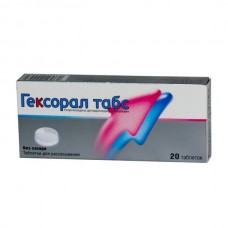Expiration date: 11/2026
Composition and form of issue:
Tablets for resorption 1 tablet contains:
chlorhexidine dihydrochloride 5 mg
benzocaine 1, 5 mg
excipients: isomalt peppermint oil menthol timol aspartam purified water
blistere in 10 PCs in the paper cartons 2 blister.
Description of dosage form:
Round biconvex opaque tablets with a rough surface from yellow-white to yellow-gray color. Allowed uneven coloring, the presence of air bubbles and slight roughness of the edges. Perhaps the appearance of the white coating (dusting).
Pharmacokinetics:
Chlorhexidine. There is no clinical data on chlorhexidine absorption through the oral mucosa. Chlorhexidine can be stored in saliva for up to 8 hours.
Benzocaine. Slightly soluble in water, which accounts for its slow absorption. Like all ether derivatives of p-aminobenzoic acid, cleaved by esterases in plasma and liver. The result is the formation of para-aminobenzoic acid and ethanol, metabolized to acetyl coenzyme A. p-aminobenzoic acid undergoes conjugation with glycine or excreted by the kidneys in unchanged form.
Description of the pharmacological action:
The double action of the drug is due to the presence of two active ingredients. Antibacterial activity of the drug due to the presence of chlorhexidine. The action of local anesthetics-benzocaine - reduces pain symptoms.
Chlorhexidine. It has a broad spectrum of antibacterial action against gram-positive and gram-negative bacteria acts by destroying the cytoplasmic membrane of the bacterial cell. It is ineffective against yeast fungi, dermatophytes, mycobacteria, some types of Pseudomonas and Proteus.
Chlorhexidine is most effective in neutral or slightly alkaline media. In an acidic environment, its activity decreases. The effectiveness is reduced in the presence of Soaps, blood and purulent discharge.
The use of tablets for resorption with chlorhexidine leads to a significant reduction in the content of bacteria in saliva. The use of chlorhexidine for several months is accompanied by a decrease in its effectiveness by reducing the sensitivity of bacteria.
Benzocaine-a local anesthetic, quickly and for a long time relieves pain in the mouth and throat. Benzocaine penetrates the lipophilic parts of the cell membrane and acts on the peripheral pain receptors of the mucosa and skin. Anesthetic action of benzocaine occurs within 15-30 with the dilution of the substance with saliva anesthetic effect gradually decreased (in 5-10 min).
Indications:
Infectious and inflammatory diseases of the throat or mouth:
- pharyngitis, angina and other inflammatory diseases of the pharynx
- stomatitis
- gingivitis.
Contraindications:
- hypersensitivity to any of the components of the drug
- wound and ulcerative lesions of the oral cavity or throat
- low concentration of cholinesterase in blood plasma
- children under 4 years of age.
With caution and only under the supervision of a doctor drug Geksoral tabs can be used in erosive, desquamative changes in the oral mucosa.
Application for pregnancy and breastfeeding:
There is no sufficient experience in the use of the drug in pregnant and lactating women.
Use of the drug Geksoral tabs during pregnancy and lactation is possible only in cases where the expected benefit to the mother exceeds the potential risk of harmful effects to the fetus and child.
Side effect:
With prolonged use, there may be a short-term taste disorder and numbness of the tongue, it is also possible a reversible change in the color of the teeth and tongue.
In the presence of hypersensitivity to benzocaine in rare cases, hypersensitivity reactions may develop up to anaphylactic shock.
Benzocaine may be the cause of methemohlobinemia in children.
Drug interaction:
Benzocaine due to the formation of its metabolite — 4-aminobenzoic acid — reduces the antibacterial activity of sulfonamides and aminosalicylates.
Sucrose, Polysorbate 80, insoluble salts of magnesium, zinc and calcium reduce the effect of chlorhexidine.
Method of application and doses:
Locally. The tablet to dissolve slowly in the mouth until dissolved.
The drug should be used immediately after the first symptoms of the disease and continue for a few days after the disappearance of symptoms.
General recommendations for dosing
Adults and children over 12 years — 1 table. every 1-2 hours if necessary, but no more than 8 tables. a day, if not appointed otherwise.
Children aged 4-12 years-up to 4 tables. per day. For use in children should consult with a doctor.
Do not use in children under 4 years.
Information for diabetic patients: carbohydrate content per tablet is 0, 1 bread ediniz (BU).
Overdose:
With proper use, overdose of the drug is impossible, since chlorhexidine is practically not absorbed into the blood, and the amount of absorbed benzocaine is extremely small.
Chlorhexidine
Symptoms: chlorhexidine hydrochloride is poorly soluble in water, all cases of overdose are described only when taking well-water-soluble gluconate chlorhexidine. In these cases, mucosal lesions were noted in direct contact with chlorhexidine gluconate, as well as a systematic reversible increase in the concentration of liver enzyme.
Treatment: no specific treatment.
Benzocaine
Overdose is possible only with the wrong application.
Symptoms: possible toxic effect on the Central nervous system, manifested initially tremor, vomiting, seizures, and later — the oppression of the Central nervous system. Due to respiratory depression possible coma. High toxic concentrations cause bradycardia, blockage of AV conduction and cardiac arrest. Benzocaine can cause methemoglobinemia, especially in children, accompanied by choking and cyanosis.
Treatment: induction of vomiting and gastric lavage. It is possible to assign activated carbon. With hypoxia and anoxia, artificial respiration with oxygen support is recommended, with cardiac arrest — heart massage. In convulsions appoint diazepam or fast barbiturates (contraindicated in anoxic convulsions) in severe cases, after intubation and artificial respiration applied suksametoniya chloride. Blood circulation should be supported by the introduction of blood plasma or electrolyte solutions. If methemohlobinemia can be applied to 50 ml of a 1% solution of methylene blue.


